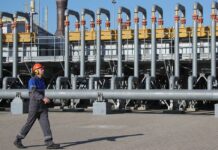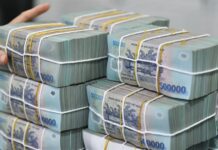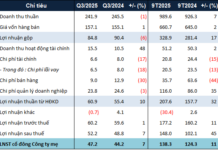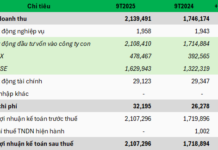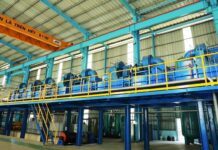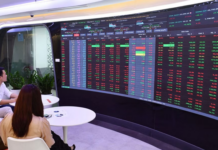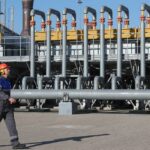The disbursement of public investment capital in 2023 sets an important momentum for localities, ministries, and sectors to continue achieving high disbursement rates in 2024 – the year of acceleration to complete the medium-term public investment plan for the period 2021 – 2025.
Boosting capital allocation
Based on the 2024 budget estimate approved by the National Assembly, the Prime Minister issued Decision 1603/2023 on the allocation of the state budget investment plan for 2024 with a total amount of VND 677,349 billion, equivalent to 95% of the 2023 plan.
Although the total state budget investment capital for 2024 slightly decreases compared to 2023, in the context of global economic difficulties and unpredictable international situation, in order to achieve a minimum disbursement rate of 95% of the allocated public investment capital, it requires strong solutions from all levels, sectors, localities, and investors.
Since the beginning of 2024, ministries, sectors, and localities have promptly allocated detailed public investment capital. For example, Thái Nguyên province has allocated 100% of the Prime Minister’s allocated capital plan for 2024, which is VND 5,612 billion, and has also allocated an additional VND 2,982 billion from local budget sources. This is an important basis and condition to promote the implementation of projects, contributing to the completion of infrastructure to attract local economic and social development investment.
Also at the beginning of the year, Hanoi set a higher public investment plan for 2024 compared to 2023. Mr. Ha Minh Hai, Vice Chairman of the Hanoi People’s Committee, said that this year the city has been allocated VND 81,033 billion in public investment capital, including VND 9,451 billion from the central budget and VND 71,582 billion from the local budget. Hanoi has promptly allocated and distributed the capital plan to ensure the disbursement progress.
Mr. Le Anh Duong, Chairman of the Bac Giang Province People’s Committee, also said that he has requested departments and agencies to vigorously disburse public investment capital to achieve 100% of the allocated plan for 2024. The province is focusing on accelerating land clearance, construction progress, removing difficulties related to mining permits, and exploiting raw materials for projects.
The determination of ministries, sectors, and localities is demonstrated by the amount of public investment capital disbursed in the first month of 2024. According to the Ministry of Finance’s report, as of the end of January 2024, the country’s disbursement of public investment capital has reached over VND 16,934 billion, achieving 2.58% of the Prime Minister’s allocated plan and higher than the same period last year.
For key projects, the total capital allocation plan for public investment in 2024 by the Ministry of Transport and localities is over VND 127,593 billion. Many important transportation projects have been implemented during the Lunar New Year period with the spirit of “overcoming challenges” and “working around the clock” to meet and exceed the progress.
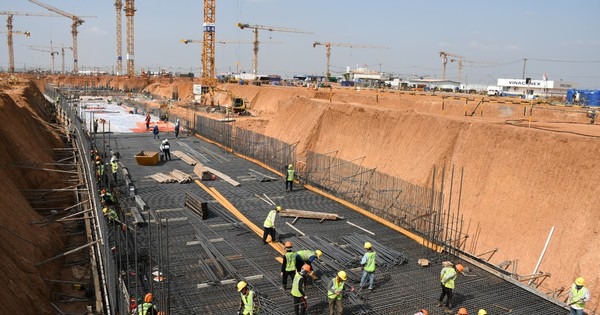
Workers and engineers working during the Lunar New Year at the Long Thanh International Airport project. Photo: NGUYEN TUAN |
Linked to the evaluation of officials
In the context of an economy facing many difficulties and challenges, public investment continues to play a role as a “seed capital” to stimulate overall investment and create an important impetus to achieve the target of 6% – 6.5% economic growth this year.
According to Minister of Planning and Investment Nguyen Chi Dung, public investment should be prioritized in order to ensure consistency in management. The minister emphasized that the same institutional framework and policies have different disbursement performance depending on the guidance and determination of the leaders. Therefore, ministries, sectors, and localities need to elevate their spirit of responsibility, set a good example, and leverage the role of leaders in directing, guiding, and organizing the disbursement of public investment capital.
Minister Nguyen Chi Dung suggested that in 2024, it is necessary to prepare, implement, and select projects that meet the conditions for capital allocation to improve readiness and feasibility. “The units directly implementing public investment plans need to actively review and provide timely and accurate information about difficulties and obstacles so that management agencies can propose fast and strong policies and solutions to meet practical requirements,” the Minister of Planning and Investment requested.
Mr. Nguyen Van Thang, Minister of Transport, said that in 2024, the entire industry will focus on accelerating disbursement and strive to achieve a minimum of 97% – 98% of the allocated capital plan. In particular, it is necessary to expedite the construction progress of ongoing projects, especially the North-South East Road project phase 2017 – 2020 and 2021 – 2025.
The Ministry of Finance also suggested that ministries, sectors, and localities continue to emphasize the responsibility of leaders in directing, supervising, and urging the disbursement of public investment capital. Publicize the implementation results of each unit, link the disbursement results of each unit to the evaluation of officials, and review and criticize cases where the plan is not completed.
At the local level, Bac Giang province has strict measures to handle investors, project management boards, organizations, and individuals who deliberately cause difficulties, obstruct, and delay the progress of implementation and disbursement of public investment capital. The Chairman of the Provincial People’s Committee affirmed that the province will promptly replace incompetent, sluggish, troublesome officials, civil servants, and officers; strictly handle negative behaviors and corruption in public investment management and implementation.
|
Expressway creates new development space Minister of Planning and Investment Nguyen Chi Dung said that there has been a restructuring of public investment towards concentrating resources on large projects, key transportation projects, especially expressways. In 2023, the country put into operation 475 km of expressways, increasing the total length of operational expressways to about 1,900 km. The expressway system has created new development spaces and corridors, promoting local economic and social development, boosting tourism, and attracting investment. Looking further, when the North-South expressway and other key transportation projects are completed, it will create a complete network of connected expressways, thereby enhancing the regional connectivity of the entire country. |
|
Separating land clearance into independent projects Dr. Hoang Van Cuong, Member of the Finance and Budget Committee of the National Assembly, analyzed that public investment creates employment opportunities and stimulates economic growth. Therefore, the Government needs to further direct ministries, sectors, and localities to find strong solutions to overcome obstacles, especially in land clearance; proactively review and shift funds early from the beginning of the year; expedite project investment procedures. Regarding land clearance obstacles, Dr. Nguyen Bich Lam, former Director General of the General Statistics Office, suggested studying mechanisms and policies to separate land clearance as independent projects, implementing them first, and delivering clean land to investors. This is necessary and effective for the implementation of infrastructure projects. |
|
Mr. Michael Kokalari, Director of the Macroeconomic Analysis and Market Research Department at VinaCapital Investment Fund: About USD 30 billion of undisbursed capital One of the solutions for Vietnam’s economic growth in 2024 is to focus on fiscal stimulus, including increasing public investment. At the beginning of 2023, the Government oriented to increase public investment by 50% to USD 30 billion, equivalent to 7% of GDP. It is likely that this is a step to support the economy amid reduced global consumption demand. The level of public investment expenditure reached about USD 25 billion last year, equivalent to 6% of GDP. The government plans to spend at a similar level this year. The prudent approach of the Government has allowed Vietnam to significantly increase public investment if necessary, as there is still around USD 30 billion of undisbursed capital, focusing on infrastructure projects. Vietnam’s debt-to-GDP ratio is currently below 40%, which is very low compared to most developing and developed countries. In addition to the impetus of public investment, the economy also has many growth prospects in other areas as credit growth is stimulated from the beginning of the year, exports recover, and foreign investment continues to increase. Dr. Phan The Cong, Head of the Department of Economics, University of Commerce: Need to eliminate dispersed investment Vietnam’s economy is challenged by both internal and external factors. To promote economic growth, one solution that the Government can implement is to support aggregate demand through effective public investment, thereby creating jobs and stimulating economic activity. Public investment continues to be an important driving force, playing a role in promoting, supporting, and compensating for the growth of other drivers. The Government and localities need to innovate in planning, allocating, and appraising public investment projects to make each project effective. The Government needs to develop a suitable public investment strategy that corresponds to each industry, sector, and locality’s investment needs. Focus on investing in large projects, eliminate dispersed investment, minimize project implementation time, urgently put projects into operation, and enhance the efficiency of public investment capital. Focus on building infrastructure, transportation systems, ports, infrastructure of industrial parks, and further invest in the energy sector – especially renewable energy and power transmission and distribution systems. T.Phuong – M.Chien Reported |
MINH PHONG



